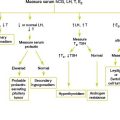Chapter 14 DIARRHEA, CHRONIC
Causes of Chronic Diarrhea
Acquired monosaccharide malabsorption
Chronic constipation with overflow diarrhea
Chronic nonspecific diarrhea of childhood
Congenital chloride-losing diarrhea
Eosinophilic gastroenteropathy
Key Historical Features
Key Physical Findings
 Weight, height, and head circumference
Weight, height, and head circumference
 General examination for evidence of dehydration
General examination for evidence of dehydration
 Head and neck examination for nasal polyps or iritis
Head and neck examination for nasal polyps or iritis
 Abdominal examination for bowel sounds, distension, tenderness
Abdominal examination for bowel sounds, distension, tenderness
 Rectal examination for prolapse, fissure, fistula, or abscess
Rectal examination for prolapse, fissure, fistula, or abscess
 Extremity examination for digital clubbing, arthritis, tremor, or edema
Extremity examination for digital clubbing, arthritis, tremor, or edema
 Skin examination for eczematous dermatitis, dermatitis herpetiformis, erythema nodosum, or pyoderma gangrenosum
Skin examination for eczematous dermatitis, dermatitis herpetiformis, erythema nodosum, or pyoderma gangrenosum
Suggested Work-up
| pH and reducing substances | The presence of reducing substances with a pH less than 6 suggests carbohydrate malabsorption |
| Occult blood | To evaluate for bleeding |
| Fatty acid crystals | Suggests a mucosal problem such as celiac disease |
| Fat globules | The presence of fat globules in an older child suggests steatorrhea but may be normal in the first few months of life |
| Microscopic exam for red blood cells (RBCs) and white blood cells (WBCs) | Neutrophils and RBCs may suggest infection or inflammatory bowel disease |
| Eosinophils suggest parasitic infestation or protein intolerance | |
| Microscopic exam for ova and parasites | To evaluate for parasite infection |
| Stool culture | To evaluate for infectious etiologies |
| Complete blood cell count (CBC) | To evaluate for infection, neutropenia, or eosinophilia. May also reveal microcytic or macrocytic anemia. |
| Erythrocyte sedimentation rate | To evaluate for infection or inflammatory bowel disease |
| Serum electrolytes | To evaluate for electrolyte disturbance |
| Serum protein and albumin levels | To evaluate for malnutrition (proportional decrease) or protein-losing enteropathy (greater loss of albumin) |
| Serum carotene level | To evaluate for fat malabsorption |
Additional Work-up
| Endomysial and tissue transglutaminase antibodies | If celiac disease is suspected |
| Giardia stool antigen | If giardiasis is suspected |
| Serum immunoglobulins | If immunodeficiency is suspected |
| HIV test | If HIV infection is suspected |
| Hydrogen breath test | If carbohydrate malabsorption is suspected |
| 72-hour fecal fat test | If fat malabsorption is suspected |
| Sweat chloride test | If cystic fibrosis is suspected |
| Upper GI series with small-bowel follow-through | If Crohn’s disease or anatomic abnormalities are suspected |
| Barium enema | If Hirschsprung’s disease or inflammatory bowel disease is suspected |
| Sigmoidoscopy | If inflammatory bowel disease or pseudomembranous colitis is suspected |
| Jejunal biopsy | To confirm the presence of celiac disease |
1. Branski D., Lerner A., Lebenthal E. Chronic diarrhea and malabsorption. Pediatr Clin North Am. 1996;43:307–328.
2. Fasano A. Clinical presentation of celiac disease in the pediatric population. Gastroenterology. 2005;128:S68-S73.
3. Hyman P.E., Milla P.J., Benninga M.A., Davidson G.P., Fleisher D.F., Taminiav J., et al. Childhood functional gastrointestinal disorders: neonate/toddler. Gastroenterology. 2006;130:1519–1526.
4. Kneepkens C.M.F., Hoekstra J.H. Chronic nonspecific diarrhea of childhood: pathophysiology and management. Pediatr Clin North Am. 1996;43:375–390.
5. Leung A.K.C., Robson W.L.M. Evaluating the child with chronic diarrhea. Am Fam Physician. 1996;53:635–643.























